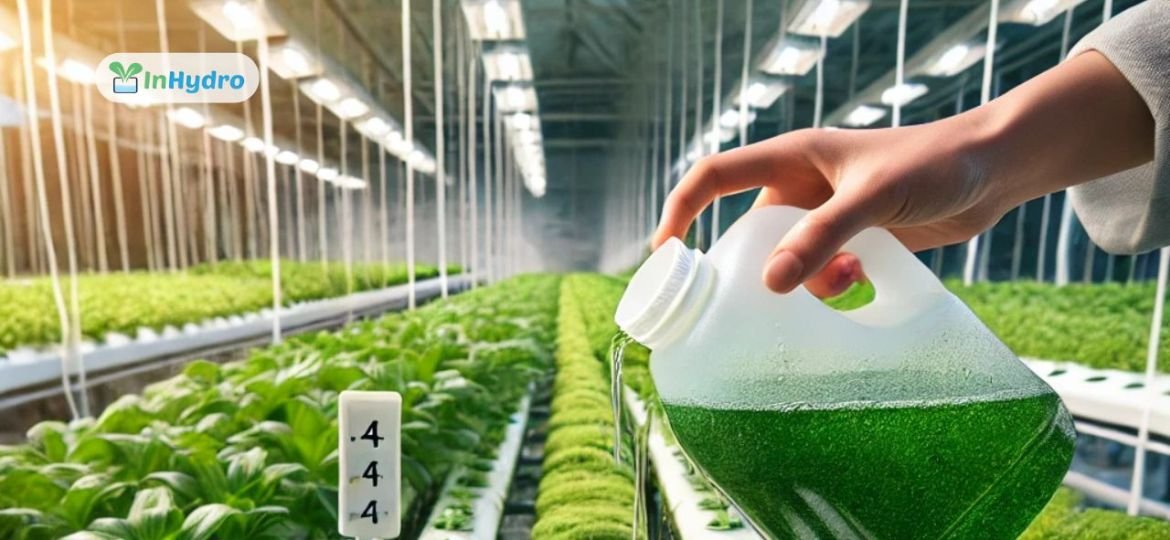
How to Prevent Algae Growth in Hydroponic Systems: Tips from InHydro
Algae growth in hydroponic systems can be a persistent challenge, leading to clogged tubing, reduced oxygen levels, and competition for nutrients. If left unmanaged, algae can create an environment that encourages the growth of harmful bacteria and fungi, affecting plant health and system efficiency.
At InHydro, we specialize in designing efficient, low-maintenance hydroponic setups that minimize the risk of algae formation. Below, we provide expert strategies to prevent algae growth and maintain a clean and productive hydroponic system.
Block Light from the Nutrient Solution
Algae require light, moisture, and nutrients to grow. Since hydroponic nutrient solutions provide ample moisture and nutrients, the best way to prevent algae formation is to block light exposure in key areas of the system.
How to Reduce Light Exposure:
- Cover nutrient reservoirs with opaque or dark-colored lids to block light.
- Use black tubing and pipes to prevent light from reaching the nutrient flow.
- Seal cracks and openings in the system where light can enter.
- Place reflective covers on open channels to prevent direct sunlight exposure.
InHydro’s Tip:
Opt for UV-resistant hydroponic containers that are designed to prevent light penetration while maintaining durability.
Improve Water Circulation and Aeration
Stagnant water creates the perfect environment for algae to thrive. Proper water circulation and aeration help prevent algae growth by ensuring continuous movement of nutrients and reducing stagnant areas where algae can develop.
Best Practices for Water Circulation:
- Use high-quality water pumps to maintain constant flow in NFT and DWC systems.
- Install air stones and air pumps to increase oxygenation in the nutrient reservoir.
- Regularly clean and unclog pipes, filters, and drippers to maintain smooth circulation.
InHydro’s Tip:
Consider automated hydroponic systems with built-in flow sensors and oxygenation control to maintain optimal water movement.
Maintain Optimal Water Temperature
Warm water accelerates algae growth, while cooler temperatures slow it down. Keeping your nutrient solution at the ideal temperature range helps discourage algae formation.
Recommended Water Temperature for Hydroponics:
- 18–22°C (64–72°F) for most leafy greens and herbs.
- 20–24°C (68–75°F) for fruiting plants like tomatoes and peppers.
Methods to Control Water Temperature:
- Use chillers or coolers for large hydroponic setups in hot climates.
- Place the nutrient reservoir in a shaded, well-ventilated area.
- Avoid placing the system near heat sources or direct sunlight.
InHydro’s Tip:
Monitor temperature fluctuations using digital sensors that provide real-time data and alerts.
Use Beneficial Additives to Control Algae
Certain natural and chemical additives help prevent algae growth without harming plants. Adding these to your nutrient solution can keep algae in check while maintaining plant health.
Recommended Additives:
- Hydrogen Peroxide (H₂O₂) – Helps sterilize water and kill algae spores.
- Beneficial Microbes – Compete with algae for resources and help maintain a balanced system.
- Grapefruit Seed Extract – A natural antifungal that inhibits algae growth.
InHydro’s Tip:
Use a low concentration of hydrogen peroxide (3-5ml per liter of water) to prevent algae without damaging plant roots.
Regular System Cleaning and Maintenance
Routine cleaning is one of the most effective ways to prevent algae buildup. Regularly flushing and sterilizing your hydroponic system ensures that algae spores do not accumulate over time.
Best Practices for Cleaning:
- Flush the system with a mild bleach or hydrogen peroxide solution every 2–4 weeks.
- Scrub reservoir walls, pipes, and grow trays to remove algae buildup.
- Replace old or contaminated water with fresh nutrient solution regularly.
InHydro’s Tip:
Use UV sterilizers in larger hydroponic setups to eliminate algae spores in the water before they spread.
Optimize pH and Nutrient Balance
Algae thrive in alkaline conditions. Keeping your nutrient solution at the ideal pH range discourages algae growth while ensuring optimal nutrient uptake for plants.
pH Levels for Hydroponics:
- Ideal Range: 5.5 – 6.5
- Algae Risk Zone: Above 7.0
How to Maintain pH Stability:
- Regularly test and adjust pH using pH meters and buffers.
- Use pH-down solutions like phosphoric acid if the pH starts rising.
- Avoid overfeeding nutrients, as excess organic matter can fuel algae growth.
InHydro’s Tip:
Use automated pH controllers that monitor and adjust pH levels in real time for precise control.
Minimize Organic Debris in the System
Decaying plant matter, dead roots, and excess nutrients provide a food source for algae. Keeping your hydroponic system free of organic debris limits algae formation.
How to Prevent Organic Buildup:
- Trim dead or dying plant leaves and roots regularly.
- Remove any unconsumed organic materials from the system.
- Clean filters and growing media to prevent accumulation of organic matter.
InHydro’s Tip:
Use mesh filters and sediment traps to capture organic particles before they circulate in the system.
Final Thoughts
Preventing algae in hydroponic systems requires a proactive approach, combining light control, proper water circulation, optimal temperature management, and routine cleaning. By implementing these best practices from InHydro, growers can maintain a clean, efficient, and productive hydroponic setup.
At InHydro, we provide customized hydroponic solutions designed to minimize algae risks and maximize plant health. Whether you’re managing a home hydroponic garden or a large-scale commercial setup, our expert recommendations and automation technologies ensure hassle-free growing.
For professional hydroponic consulting, system design, and automation solutions, contact InHydro today!

